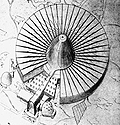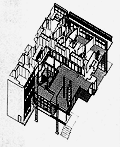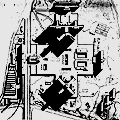Composite Modernism:
The Architectural Strategies of Paul Nelson and Oscar Nitzchke
© 1995 Sean Daly
chronology | 1920-1939
[CONTINUE] Beyond Palais de Bois:The Prototype for a Small-Scale Hospital and the Health City of Lille
 Palais
de Decouverte
Palais
de Decouverte
In prior articles on Parisian architecture of the 1930s, most writers have discussed the work of Paul Nelson and Oscar Nitzchke separately, relating the two only with the Palais de Decouverte of 1938, the only project publically acknowledged as a collaboration between the two. Rarely mentioned is the fact that Nelson had hired Nitzchke as his firm's "head designer" as early as 1931, and that Nitzchke was deeply involved in the design of Nelson's "Prototype of a Small-Scale Hospital," the Health Complex at Lille, the Ismailia surgery pavilion, and the CBS Broadcasting building of 1936. In fact, the Maison Suspendu and the WGN Radio studio competition of 1938 are the only Nelson projects of the 1930s to be done entirely independent of Nitzchke; Nelson would accept the Palace of Discovery commission only on the condition that Nitzchke also be brought in. [1]
It is only in recognizing this ongoing partnership, as well as the larger circle of architects and theorists the two were involved with, that their immensely innovative work can be adequately explained. The purpose of this essay is to delineate the architectural strategies of Paul Nelson and Oscar Nitzchke as they emerged in those "theoretical" projects from 1934 to 1938. Though these projects would remain for various reasons unbuilt, they were influential and well-publicized in their own day. They convey a breed of modernism -- a sensibility and formal approach to architecture -- truly unique to Paris of the 1930s, one that would be entirely eclipsed during the post-war reconstruction by the overly monumental and monosyllabic tendancies of Brutalism and the larger hegemony of the International Style.
Despite the obvious imprint of Perret, Corbusier, and Chareau, the mature work of Nelson and Nitzchke embodies a "composite" modernism quite distinct from its origins. Perret's emphasis on explicit structure would be kept, but often utilized in steel and in buildings simultaneously employing both compressive and tensile structural systems. The labored consistency of Perret's poche would be replaced by a method of explicit grafting, with each building becoming a sectored hybrid of rationalist concrete and constructivist steel. Corbusier's plan libre would be consciously pushed to the "free section" (a term in fact coined by Nelson), and the Ecole de Paris "stratification of space" (a poetic strategy Colin Rowe has described in detail) would be superseded by a notion of three-dimensional "spatial density and release" derived from Helion, Zervos, and Nelson's own readings of Leger's paintings of the early thirties. [2]
 Maison
de Verre sectional axonometric
Maison
de Verre sectional axonometric
Only the Maison de Verre--with its "transformable plan," pan verre facade, and deep reconceptualizing of the medical and domestic program--seems to be kept as an on-going inspiration for the two. In the specificity of its problem solving, it is most akin to Nelson's own methodological concerns and its formal properties will be extensively theorized by the young American. Its influence can be seen as early as the Lille Health City, in the patented translucent paneling system and the elaborate architectural projections of the medical equipment.
 Lille Health City Plan
Lille Health City Plan
Ultimately,
it would inspire an architectural process Nelson would call "deep functionalism"
which broke with the simple form-function analogue of more dogmatic modernisms
and consciously crafted spaces that embodied a spectrum of possible use. Combined
with direct influences by Giacometti, Bodiansky, and Le Ricolais, Nelson and
Nitzchke will make this functionalism take on an even more vivid and expressive
form, consciously looking to surrealism and the anexact geometries of biology
for inspiration.
While the general tendancy in modern architecture in the 1930s became more
stylistic and petrified along political lines, architects like Frederick Keisler,
Jean Prouve, Nelson and Nitzchke would continue to cultivate what has been
called by Bruno Reichlin a "radically functionalist" approach, utilizing methods
that presupposed unknowable results and intentionally culminated in solutions
beyond stylistic convention. [3] Steeped
in the restraint and rationality of Perret and the polytechnic tradition of
France, liberated through Corbusier's presence, they were part of a larger
"light-wing of the Ecole de Paris" which would exist briefly in the cosmopolitan
atmosphere of Paris before the Munich Appeasement. [4]
Including Marcel Lods, Eugene Beaudoin, and Vladimir Bodiansky, this group
developed a tempered constructivist enthusiasm for the use of steel as well
as a nuanced and sophisticated conception of urban experience that would not
be regained in modern architecture until the 1960s.
[CONTINUE]
Beyond Palais de Bois:The Prototype for a Small-Scale
Hospital and the Health City of Lille
zones |
-
RETURN
| basilisk
MORE | eCRITS
PREVIOUS | VENICE & THE VIRTUAL
NEXT | A DRINK WITH ANGELA
MORE DETAIL | NN2